牛津译林版(2019)必修第三册Unit 4 Scientists who changed the world Grammar and usage 课件(共36张PPT)
文档属性
| 名称 | 牛津译林版(2019)必修第三册Unit 4 Scientists who changed the world Grammar and usage 课件(共36张PPT) | 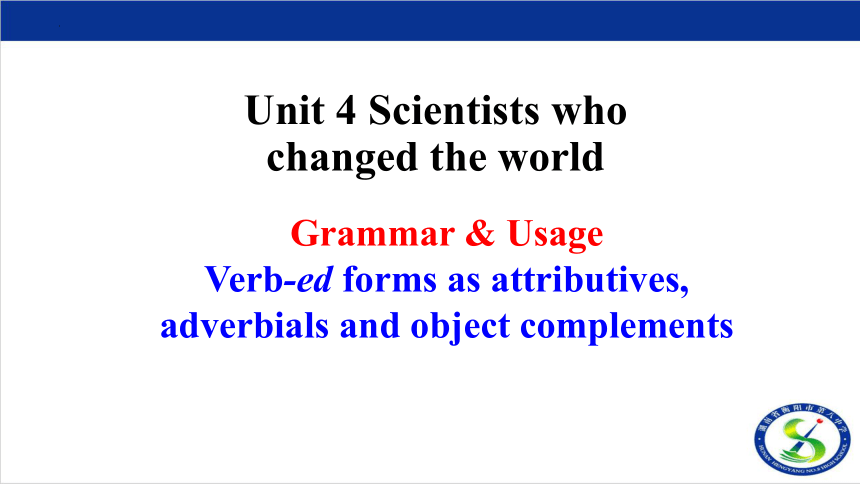 | |
| 格式 | pptx | ||
| 文件大小 | 1.6MB | ||
| 资源类型 | 教案 | ||
| 版本资源 | 牛津译林版(2019) | ||
| 科目 | 英语 | ||
| 更新时间 | 2023-07-14 08:06:50 | ||
图片预览

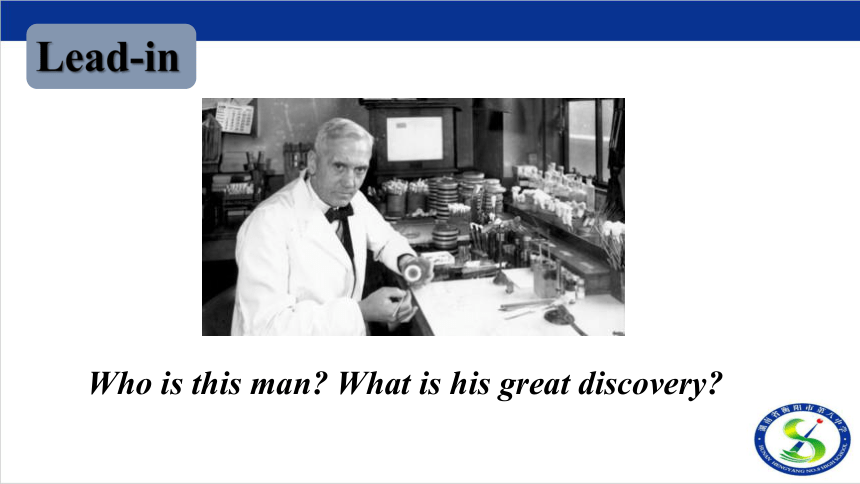

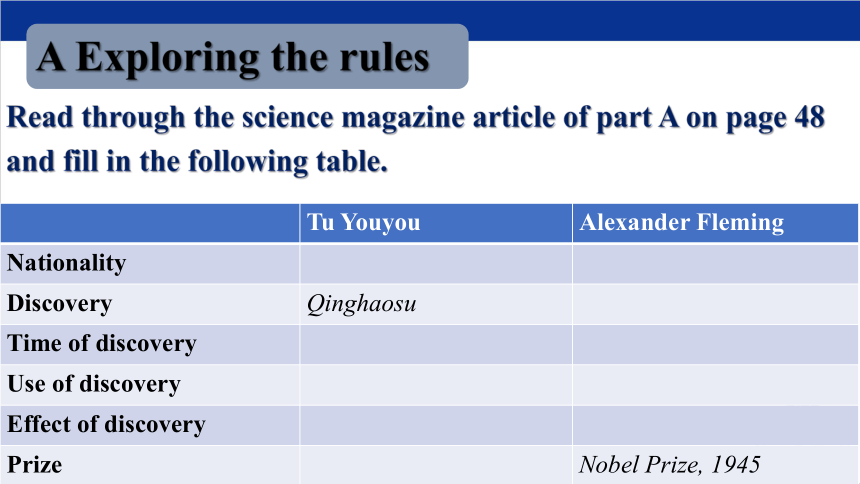
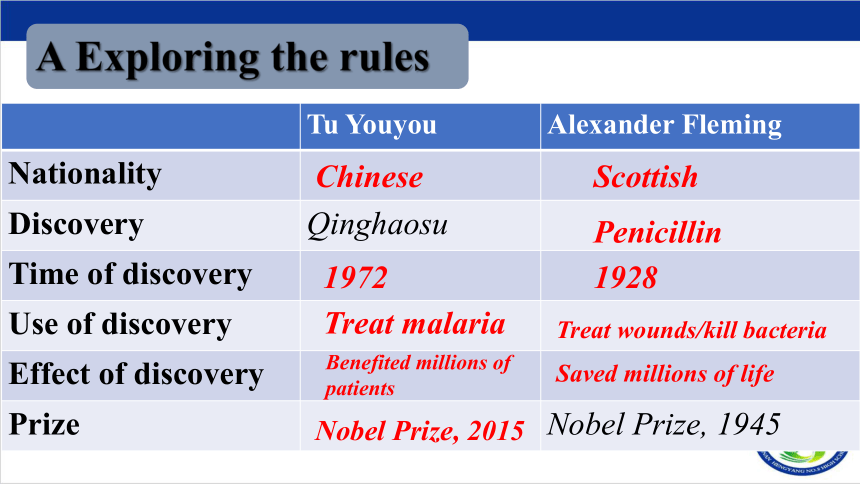
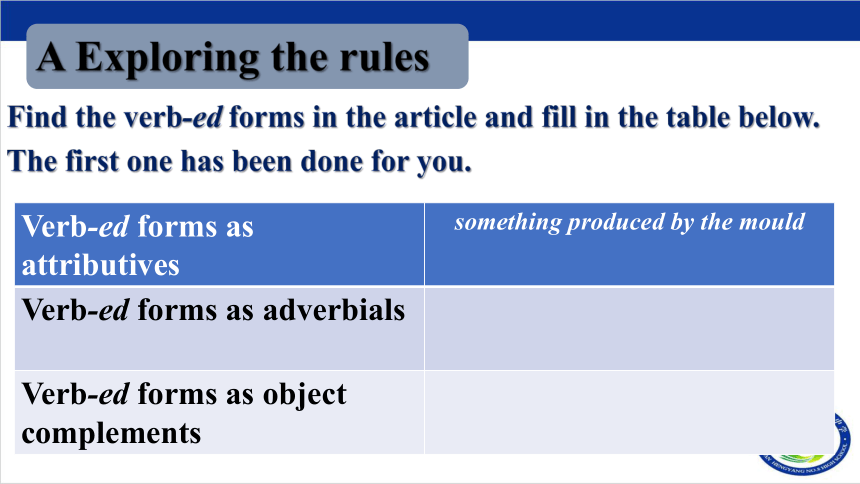
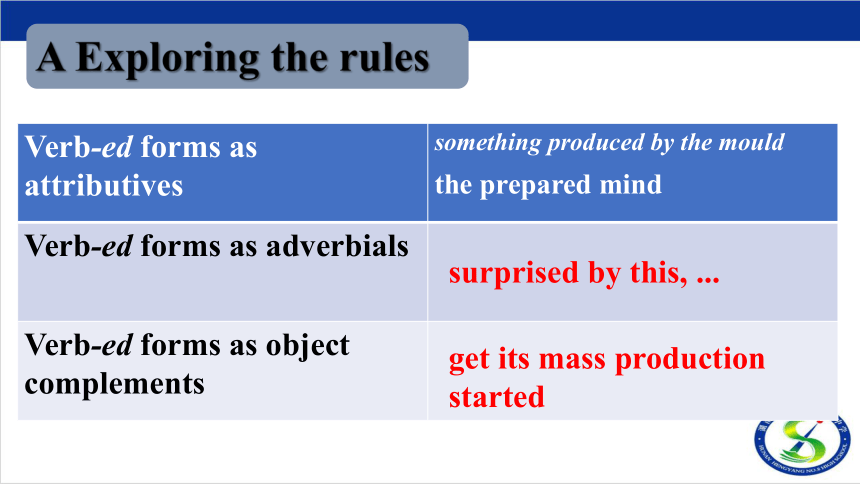
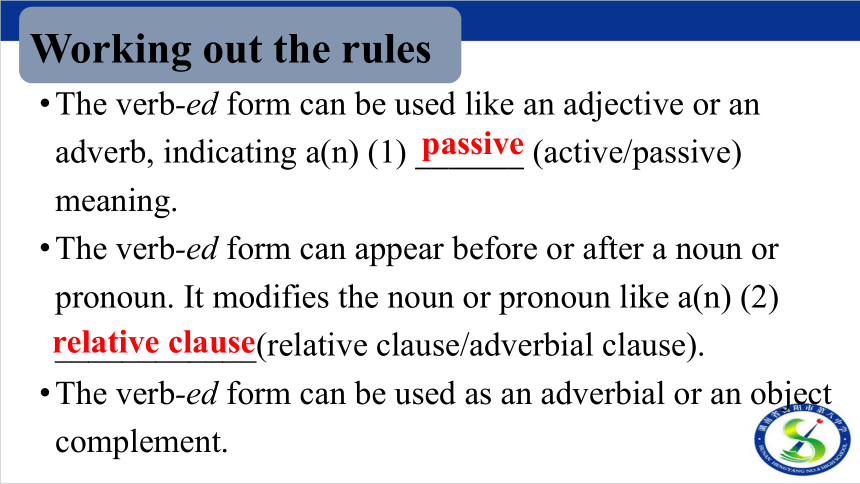
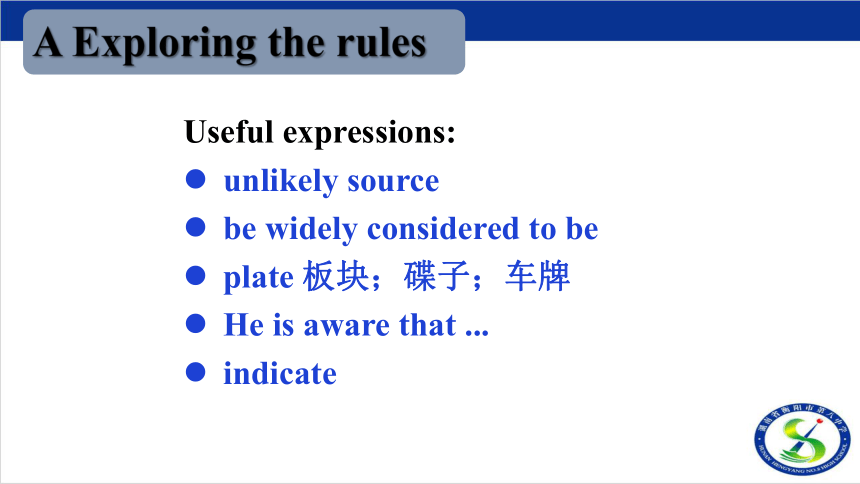
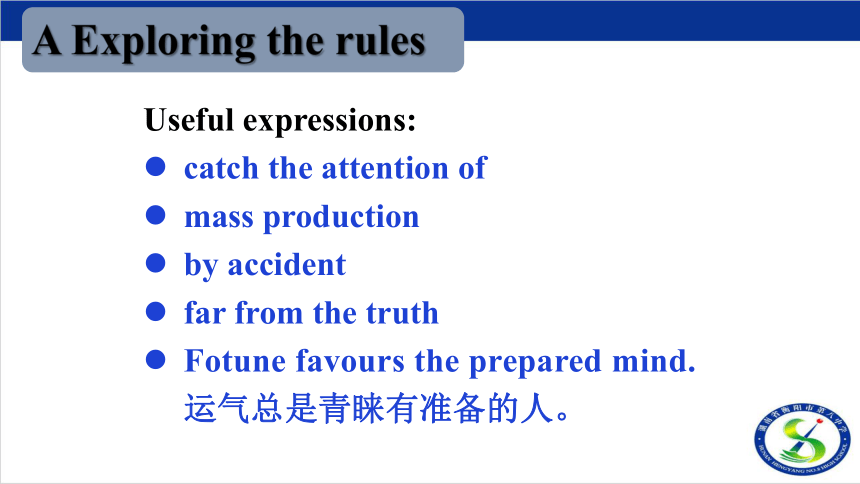

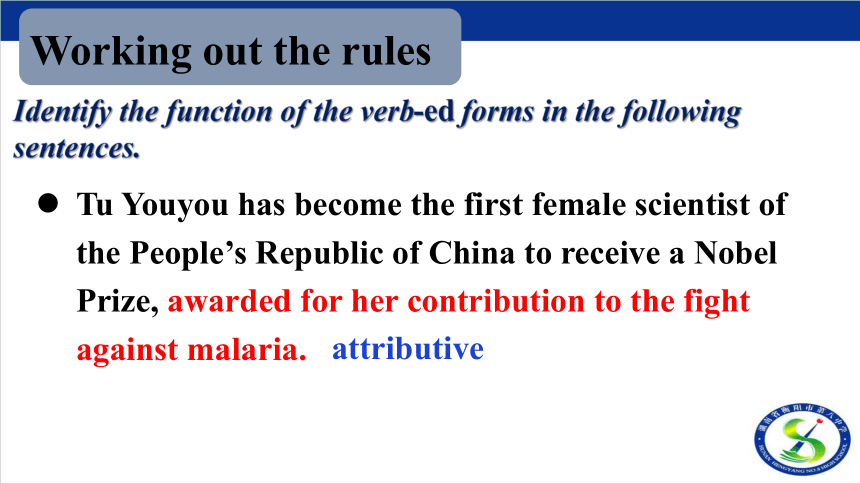
文档简介
(共36张PPT)
Grammar & Usage
Verb-ed forms as attributives, adverbials and object complements
Unit 4 Scientists who changed the world
Who is this man What is his great discovery
Lead-in
Alexander Fleming, (born August 6, 1881—died March 11, 1955, London, England), Scottish bacteriologist best known for his discovery of penicillin.
Lead-in
A Exploring the rules
Read through the science magazine article of part A on page 48 and fill in the following table.
Tu Youyou Alexander Fleming
Nationality
Discovery Qinghaosu
Time of discovery
Use of discovery
Effect of discovery
Prize Nobel Prize, 1945
A Exploring the rules
Tu Youyou Alexander Fleming
Nationality
Discovery Qinghaosu
Time of discovery
Use of discovery
Effect of discovery
Prize Nobel Prize, 1945
Chinese
Scottish
1972
Penicillin
1928
Treat malaria
Treat wounds/kill bacteria
Benefited millions of patients
Saved millions of life
Nobel Prize, 2015
A Exploring the rules
Find the verb-ed forms in the article and fill in the table below. The first one has been done for you.
Verb-ed forms as attributives something produced by the mould
Verb-ed forms as adverbials
Verb-ed forms as object complements
A Exploring the rules
Verb-ed forms as attributives something produced by the mould
Verb-ed forms as adverbials
Verb-ed forms as object complements
the prepared mind
surprised by this, ...
get its mass production started
The verb-ed form can be used like an adjective or an adverb, indicating a(n) (1) (active/passive) meaning.
The verb-ed form can appear before or after a noun or pronoun. It modifies the noun or pronoun like a(n) (2) ____________(relative clause/adverbial clause).
The verb-ed form can be used as an adverbial or an object complement.
passive
relative clause
Working out the rules
A Exploring the rules
Useful expressions:
unlikely source
be widely considered to be
plate 板块;碟子;车牌
He is aware that ...
indicate
A Exploring the rules
Useful expressions:
catch the attention of
mass production
by accident
far from the truth
Fotune favours the prepared mind. 运气总是青睐有准备的人。
Go through the notes on page 100 and page 101.
Working out the rules
Working out the rules
Identify the function of the verb-ed forms in the following sentences.
Tu Youyou has become the first female scientist of the People’s Republic of China to receive a Nobel Prize, awarded for her contribution to the fight against malaria.
attributive
Working out the rules
Thanks to her discovery of qinghaosu, malaria patients all over the world now have had a greatly increased chance of suvival.
attributive
Working out the rules
Born in 1930, in Ningbo, Zhejiang Province, Tu studied medicine at university in Beijing between 1951 and 1955.
adverbial
Working out the rules
Inspired by an over 1,600-year-old text about preparing qinghao extract with cold water, Tu redesigned the experiments and tried extracting the herb at a low temperature in order not to damage its effective part.
adverbial
Working out the rules
Even with large amounts of qinghao extract produced, however, they still face another problem.
object complement
Tips1:
注意下面过去分词作定语的几种情况:
单个的过去分词作定语一般放在被修饰的名词之前。
We needed much more qualified workers.
我们需要更多的合格的工人。
My friend is a returned student.
我的朋友是个归国的留学生。
Tips1:
单个分词也可以作后置定语,用以强调动作。
They decided to change the material used.
他们决定更换使用的材料。
过去分词短语作定语要放在被修饰的名词后面,作后置定语,其作用相当于一个定语从句。
The student dressed in white is my daughter.
=The student who is dressed in white is my daughter.
穿白色衣服的学生是我的女儿。
Tips1:
单个过去分词前加一名词或副词,常用连字符将它们连接起来构成一个复合形容词,放在其修饰的名词前,作前置定语。例如:
This is a state-owned factory.
这是一家国营工厂。
This is our school-run factory.
这是我们的校办工厂。
Tips1:
作前置定语的某些动词的过去分词的形式与作谓语或表语的过去分词的形式往往不一样。
light lighted; light lit
We lit the candle and the candle lit up the room.
我们点着蜡烛,蜡烛照亮房间。
There is a lighted candle on the table.
桌上有一支点着的蜡烛。
Tips 2:
过去分词作宾补用法归纳
英语中过去分词可作宾补,表被动意义或完成意义。
She found the door broken in when she came back.
(宾补与宾语有被动的关系,表一种状态。)
Tips 2:
过去分词用在表状态的动词keep、leave等的后面。
They kept the door locked for a long time.
Keep your mouth shut and your eyes open.
(谚语:少说多看)
Don't leave such an important thing undone.
Don't leave the windows broken like this all the time.
Tips 2:
过去分词用在使役动词get、have、make的后面。
The old man had his leg broken in the accident.
They managed to make themselves understood in very simple English.
I raised my voice to make myself heard.
Tips 2:
过去分词用在感观动词watch、notice、see、hear、listen to、feel、find等后面。如:
When we got to school, we saw the door locked.
We can hear the windows beaten by the heavy rain drops.
The managers discussed the plan that they would like to see carried out the next year.
Tips 2:
过去分词用在want、wish、like、expect等表示“希望,愿望”这一类动词后面做宾补。如
The boss wouldn't like the problem discussed at the moment.
I want the suit made to his own measure.
I wish the problem settled.
Tips 2:
过去分词用在“with +宾语+宾补”这一结构中,
过去分词与宾语之间是动宾关系。如:
The thief was brought in with his hands tied behind his back.
With many brightly-coloured flowers planted around the building, his house looks like a beautiful garden.
With everything well arranged, he left the office.
B Applying the rules
Finish B1 on page 49 and tell the function of the v-ed forms.
Possible answer
1. The highly praised scientist won an award.
2. The experiment mentioned in your article is interesting.
3. Treated with the new medicine, the patients soon recovered.
定语
定语
状语
B Applying the rules
4. The scientist found the equipment in the laboratory destroyed.
5. Once finished, this report will be very useful for future research.
补语
状语
B Applying the rules
Finish B2 on page 49 and tell the part of speech of the v-ed forms.
Answer
1. interesting 宾补
2. Knowing 状语
3. tied 定语
4. Conducted 状语
5. accepted 宾补
6. arguing 状语
B Applying the rules
Finish B2 on page 49 and answer the following question.
Why was Franklin’s experiment questioned
Because many people believed that if he had really done the experiment, he would have received a deadly electric shock.
Useful expressions in B2 :
The story goes like this ...
work out 计算出
charge 负责;收费;充电
conduct an experiment
a stormy day
a deadly electric shock
B Applying the rules
Finish B3 on page 49 and write a short paragraph using v-ed,
v-ing and to-infinitives..
Looking at a world map, Alfred Wegener found something amazing: the eastern coastline of South America and the western coastline of Africa seemed to fit together. He did more research to find out what caused this. Having collected enough evidence, he put forward his theory of continental drift. Then he had his ideas published in The Origin of Continents and Oceans. However, people did not believe in his theory. For one thing, it challenged many scientific theories widely accepted at that time. For another, Wegener failed to explain the driving force causing the continents to drift apart.
Useful expressions in B3:
put forward the theory
continental drift
challenge the theory
partly because
the driving force
Homework
Finish Exercise C on P76
B1
Rewrite the following sentences using verb-ed forms.
built in 1900 定语
reserved for the disabled 定语
Encouraged/Having been encouraged by what Jane said 状语
Unless invited 状语
Homework Checking
Possible answer
P76
B1
5. the car stuck 补语
6. Inspired by the young man 状语
7. locked inside 定语
8. If given more time 状语
Homework Checking
Possible answer
P76
Rewrite the following sentences using verb-ed forms .
Grammar & Usage
Verb-ed forms as attributives, adverbials and object complements
Unit 4 Scientists who changed the world
Who is this man What is his great discovery
Lead-in
Alexander Fleming, (born August 6, 1881—died March 11, 1955, London, England), Scottish bacteriologist best known for his discovery of penicillin.
Lead-in
A Exploring the rules
Read through the science magazine article of part A on page 48 and fill in the following table.
Tu Youyou Alexander Fleming
Nationality
Discovery Qinghaosu
Time of discovery
Use of discovery
Effect of discovery
Prize Nobel Prize, 1945
A Exploring the rules
Tu Youyou Alexander Fleming
Nationality
Discovery Qinghaosu
Time of discovery
Use of discovery
Effect of discovery
Prize Nobel Prize, 1945
Chinese
Scottish
1972
Penicillin
1928
Treat malaria
Treat wounds/kill bacteria
Benefited millions of patients
Saved millions of life
Nobel Prize, 2015
A Exploring the rules
Find the verb-ed forms in the article and fill in the table below. The first one has been done for you.
Verb-ed forms as attributives something produced by the mould
Verb-ed forms as adverbials
Verb-ed forms as object complements
A Exploring the rules
Verb-ed forms as attributives something produced by the mould
Verb-ed forms as adverbials
Verb-ed forms as object complements
the prepared mind
surprised by this, ...
get its mass production started
The verb-ed form can be used like an adjective or an adverb, indicating a(n) (1) (active/passive) meaning.
The verb-ed form can appear before or after a noun or pronoun. It modifies the noun or pronoun like a(n) (2) ____________(relative clause/adverbial clause).
The verb-ed form can be used as an adverbial or an object complement.
passive
relative clause
Working out the rules
A Exploring the rules
Useful expressions:
unlikely source
be widely considered to be
plate 板块;碟子;车牌
He is aware that ...
indicate
A Exploring the rules
Useful expressions:
catch the attention of
mass production
by accident
far from the truth
Fotune favours the prepared mind. 运气总是青睐有准备的人。
Go through the notes on page 100 and page 101.
Working out the rules
Working out the rules
Identify the function of the verb-ed forms in the following sentences.
Tu Youyou has become the first female scientist of the People’s Republic of China to receive a Nobel Prize, awarded for her contribution to the fight against malaria.
attributive
Working out the rules
Thanks to her discovery of qinghaosu, malaria patients all over the world now have had a greatly increased chance of suvival.
attributive
Working out the rules
Born in 1930, in Ningbo, Zhejiang Province, Tu studied medicine at university in Beijing between 1951 and 1955.
adverbial
Working out the rules
Inspired by an over 1,600-year-old text about preparing qinghao extract with cold water, Tu redesigned the experiments and tried extracting the herb at a low temperature in order not to damage its effective part.
adverbial
Working out the rules
Even with large amounts of qinghao extract produced, however, they still face another problem.
object complement
Tips1:
注意下面过去分词作定语的几种情况:
单个的过去分词作定语一般放在被修饰的名词之前。
We needed much more qualified workers.
我们需要更多的合格的工人。
My friend is a returned student.
我的朋友是个归国的留学生。
Tips1:
单个分词也可以作后置定语,用以强调动作。
They decided to change the material used.
他们决定更换使用的材料。
过去分词短语作定语要放在被修饰的名词后面,作后置定语,其作用相当于一个定语从句。
The student dressed in white is my daughter.
=The student who is dressed in white is my daughter.
穿白色衣服的学生是我的女儿。
Tips1:
单个过去分词前加一名词或副词,常用连字符将它们连接起来构成一个复合形容词,放在其修饰的名词前,作前置定语。例如:
This is a state-owned factory.
这是一家国营工厂。
This is our school-run factory.
这是我们的校办工厂。
Tips1:
作前置定语的某些动词的过去分词的形式与作谓语或表语的过去分词的形式往往不一样。
light lighted; light lit
We lit the candle and the candle lit up the room.
我们点着蜡烛,蜡烛照亮房间。
There is a lighted candle on the table.
桌上有一支点着的蜡烛。
Tips 2:
过去分词作宾补用法归纳
英语中过去分词可作宾补,表被动意义或完成意义。
She found the door broken in when she came back.
(宾补与宾语有被动的关系,表一种状态。)
Tips 2:
过去分词用在表状态的动词keep、leave等的后面。
They kept the door locked for a long time.
Keep your mouth shut and your eyes open.
(谚语:少说多看)
Don't leave such an important thing undone.
Don't leave the windows broken like this all the time.
Tips 2:
过去分词用在使役动词get、have、make的后面。
The old man had his leg broken in the accident.
They managed to make themselves understood in very simple English.
I raised my voice to make myself heard.
Tips 2:
过去分词用在感观动词watch、notice、see、hear、listen to、feel、find等后面。如:
When we got to school, we saw the door locked.
We can hear the windows beaten by the heavy rain drops.
The managers discussed the plan that they would like to see carried out the next year.
Tips 2:
过去分词用在want、wish、like、expect等表示“希望,愿望”这一类动词后面做宾补。如
The boss wouldn't like the problem discussed at the moment.
I want the suit made to his own measure.
I wish the problem settled.
Tips 2:
过去分词用在“with +宾语+宾补”这一结构中,
过去分词与宾语之间是动宾关系。如:
The thief was brought in with his hands tied behind his back.
With many brightly-coloured flowers planted around the building, his house looks like a beautiful garden.
With everything well arranged, he left the office.
B Applying the rules
Finish B1 on page 49 and tell the function of the v-ed forms.
Possible answer
1. The highly praised scientist won an award.
2. The experiment mentioned in your article is interesting.
3. Treated with the new medicine, the patients soon recovered.
定语
定语
状语
B Applying the rules
4. The scientist found the equipment in the laboratory destroyed.
5. Once finished, this report will be very useful for future research.
补语
状语
B Applying the rules
Finish B2 on page 49 and tell the part of speech of the v-ed forms.
Answer
1. interesting 宾补
2. Knowing 状语
3. tied 定语
4. Conducted 状语
5. accepted 宾补
6. arguing 状语
B Applying the rules
Finish B2 on page 49 and answer the following question.
Why was Franklin’s experiment questioned
Because many people believed that if he had really done the experiment, he would have received a deadly electric shock.
Useful expressions in B2 :
The story goes like this ...
work out 计算出
charge 负责;收费;充电
conduct an experiment
a stormy day
a deadly electric shock
B Applying the rules
Finish B3 on page 49 and write a short paragraph using v-ed,
v-ing and to-infinitives..
Looking at a world map, Alfred Wegener found something amazing: the eastern coastline of South America and the western coastline of Africa seemed to fit together. He did more research to find out what caused this. Having collected enough evidence, he put forward his theory of continental drift. Then he had his ideas published in The Origin of Continents and Oceans. However, people did not believe in his theory. For one thing, it challenged many scientific theories widely accepted at that time. For another, Wegener failed to explain the driving force causing the continents to drift apart.
Useful expressions in B3:
put forward the theory
continental drift
challenge the theory
partly because
the driving force
Homework
Finish Exercise C on P76
B1
Rewrite the following sentences using verb-ed forms.
built in 1900 定语
reserved for the disabled 定语
Encouraged/Having been encouraged by what Jane said 状语
Unless invited 状语
Homework Checking
Possible answer
P76
B1
5. the car stuck 补语
6. Inspired by the young man 状语
7. locked inside 定语
8. If given more time 状语
Homework Checking
Possible answer
P76
Rewrite the following sentences using verb-ed forms .
同课章节目录
- Unit 1 Nature in the balance
- Welcome to the unit
- Reading
- Grammar and usage
- Integrated skills
- Extended reading
- Project
- Unit 2 Natural disasters
- Welcome to the unit
- Reading
- Grammar and usage
- Integrated skills
- Extended reading
- Project
- Unit 3 The world online
- Welcome to the unit
- Reading
- Grammar and usage
- Integrated skills
- Extended reading
- Project
- Unit 4 Scientists who changed the world
- Welcome to the unit
- Reading
- Grammar and usage
- Integrated skills
- Extended reading
- Project
